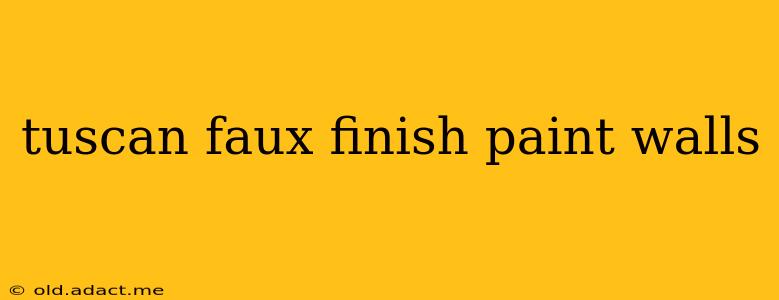The warm, earthy tones and rustic charm of Tuscany have captivated homeowners for years. Recreating this idyllic aesthetic in your home is easier than you might think, particularly with the help of a Tuscan faux finish paint technique on your walls. This guide delves into the art of achieving this look, addressing common questions and providing expert tips to help you transform your space into a tranquil Italian retreat.
What is a Tuscan Faux Finish?
A Tuscan faux finish is a painting technique designed to mimic the texture and appearance of aged plaster or stone commonly found in Tuscan architecture. It typically involves layering different shades of warm, earthy colors – think terracotta, ochre, sienna, and umber – to create depth and visual interest. The final effect is a rustic, lived-in feel that evokes the sun-drenched landscapes of Tuscany. It's more than just a simple paint job; it's an artistic approach to wall décor that adds character and sophistication.
What Colors Are Best for a Tuscan Faux Finish?
The beauty of a Tuscan faux finish lies in its versatility. While traditional colors like terracotta and ochre are staples, you have considerable room for personalization. Consider these popular color palettes:
- Classic Tuscan: Terracotta, burnt orange, warm browns, and muted yellows.
- Rustic Tuscan: Deep browns, muted greens, and creamy beige, emphasizing the aged stone effect.
- Modern Tuscan: Softer versions of traditional Tuscan colors, incorporating grays and creams for a more contemporary feel.
Remember to choose colors that complement your existing décor and furniture. Test paint samples on your walls in various lighting conditions before committing to a final choice.
How Do I Create a Tuscan Faux Finish on My Walls?
Creating a Tuscan faux finish requires some patience and artistic skill, but the results are well worth the effort. Here's a simplified overview of the process:
- Preparation: Properly prepare your walls by cleaning, patching, and priming them. A high-quality primer will ensure the paint adheres well and provides an even base.
- Base Coat: Apply a base coat of your lightest color. This will be the foundation upon which you'll build the layers of color and texture.
- Glazing: Apply a glaze (a translucent paint) in a darker, complementary shade. Use a rag or sponge to create the textured effect. The technique involves dabbing, wiping, and blending to achieve the desired level of texture and depth.
- Highlighting: Once the glaze is dry, you can add highlights with even lighter shades, using a dry brush technique to create subtle variations in tone and texture.
- Distressing (Optional): For a more aged look, consider lightly distressing the finish with sandpaper, creating subtle chips and wear.
What Tools Do I Need for a Tuscan Faux Finish?
You'll need the following tools to create a successful Tuscan faux finish:
- Paint rollers and brushes: Various sizes for applying the base coat, glaze, and highlights.
- Sponges and rags: For applying and blending the glaze.
- Paint trays: To hold your paint.
- Sandpaper (optional): For distressing the finish.
- Painter's tape: To protect areas you don't want to be painted.
How Much Does it Cost to Get a Tuscan Faux Finish?
The cost of a Tuscan faux finish can vary depending on several factors, including the size of the area, the quality of paint used, and whether you hire a professional or do it yourself. DIY projects will generally be more cost-effective, while hiring a professional painter will come with a higher price tag but potentially a higher-quality finish. Remember to factor in the cost of paints, primers, tools, and any additional materials needed.
Can I Apply a Tuscan Faux Finish Over Existing Paint?
Generally, yes, you can apply a Tuscan faux finish over existing paint, provided the existing paint is in good condition and adheres well to the wall. However, it's always best to clean and prime the surface before applying the new finish. This ensures better adhesion and a more even, professional result.
How Long Does a Tuscan Faux Finish Last?
With proper preparation and application, a well-executed Tuscan faux finish can last for many years. Regular cleaning with a soft cloth and mild detergent will help maintain its appearance. Touch-ups may be necessary over time, particularly in high-traffic areas.
This guide provides a comprehensive overview of achieving a stunning Tuscan faux finish on your walls. Remember that practice makes perfect, so don't be afraid to experiment and find your own unique style within this beautiful aesthetic. With a little patience and the right techniques, you can transform your home into a haven of Tuscan charm.
